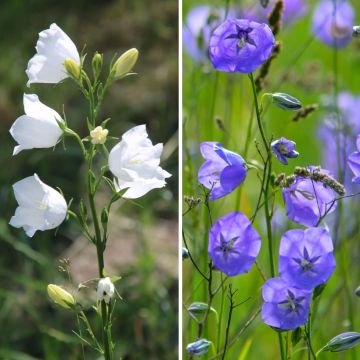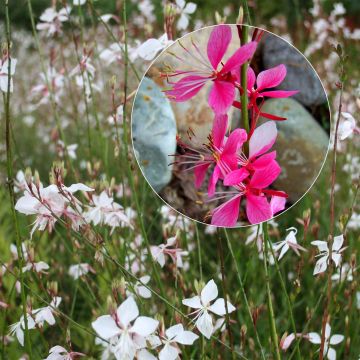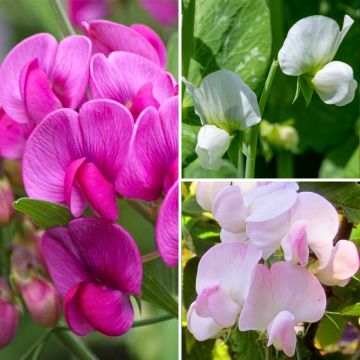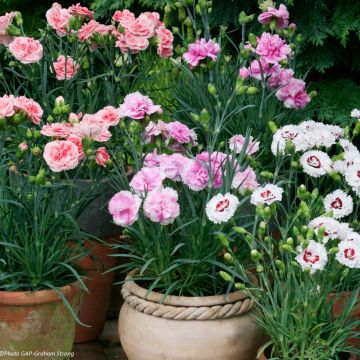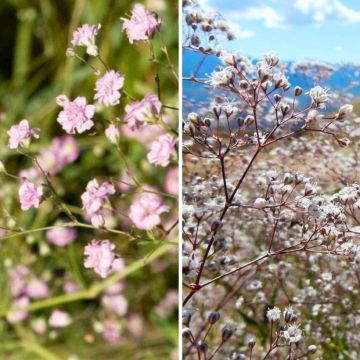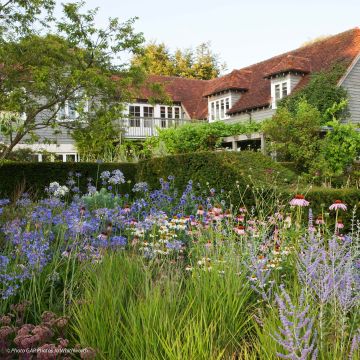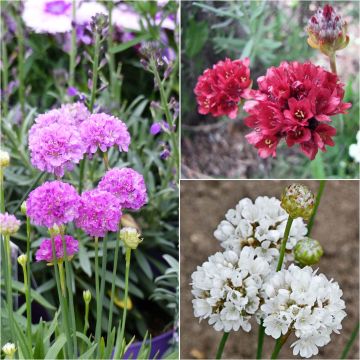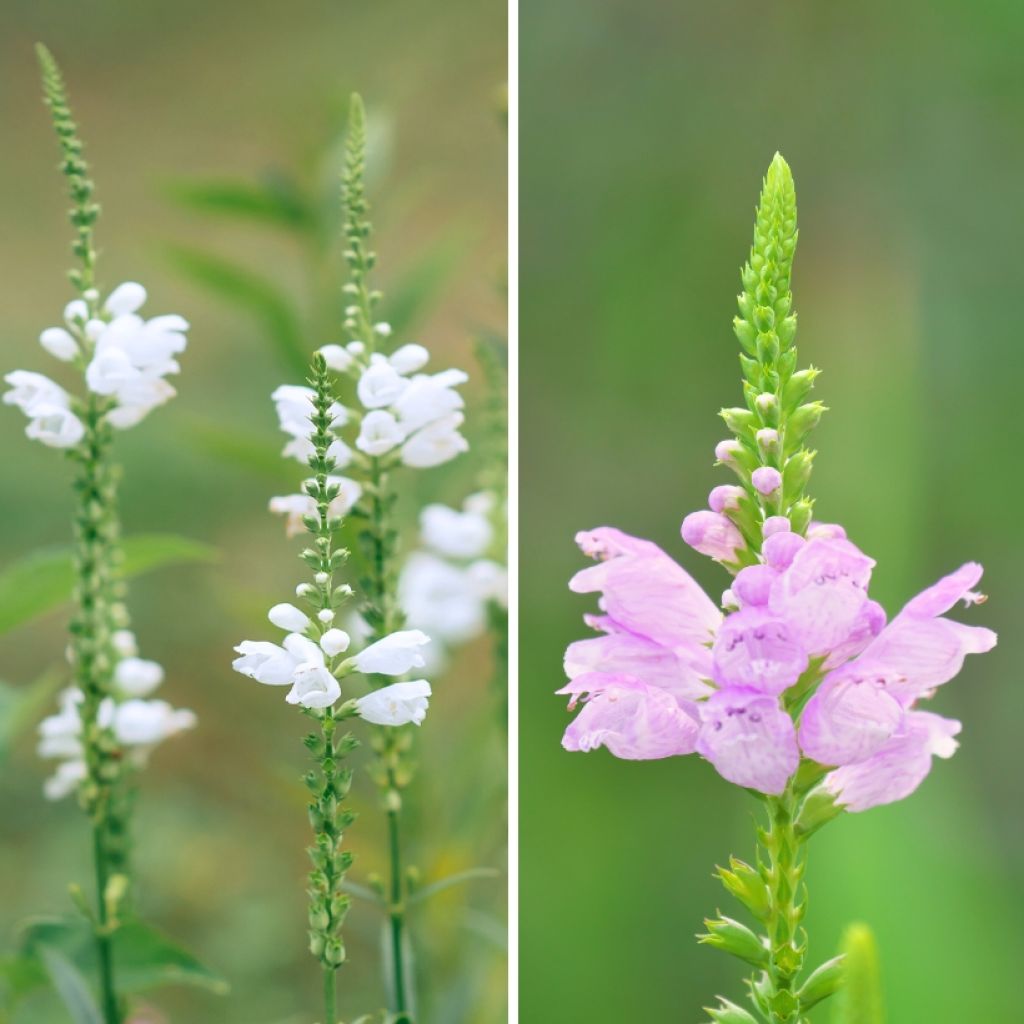

Duo of White and Pink Physostegias
Duo of White and Pink Physostegias
Physostegia virginiana Alba, Bouquet Rose
False dragonhead
This plant carries a 12 months recovery warranty
More information
We guarantee the quality of our plants for a full growing cycle, and will replace at our expense any plant that fails to recover under normal climatic and planting conditions.
Does this plant fit my garden?
Set up your Plantfit profile →
Collection items (2 plants)
Description
This duo of white and pink cataleptic plants brings together the Physostegia virginiana 'Alba' and the P. virginiana 'Bouquet Rose', two beautiful perennial varieties that thrive in moist soil and are known for their long summer flowering period. Robust and very hardy, these plants form wide clumps and produce narrow spikes that are slightly stiff and adorned with geometrically arranged flowers. When these mischievous flowers are touched, they permanently change their orientation around the axis of the inflorescence, as if struck by catalepsy. These plants are stunning when planted near ponds and other wet areas, in full sun.
The duo consists of:
1 x Physostegia virginiana 'Alba': this variety stands out with its pure white flowers, creating a striking contrast with the green foliage. It can reach a height of up to 90 cm.
1 x Physostegia virginiana 'Bouquet Rose': its bright pink flowers add a warmer touch of colour. This variety is slightly smaller, reaching a height of about 60 cm.
To achieve a harmonious effect, we recommend planting the slightly smaller Physostegia virginiana 'Bouquet Rose' at the front of the bed or border. The taller Physostegia virginiana 'Alba' can be placed behind it or to its side. For optimal results, plant approximately 5 plants per square metre and leave a distance of at least 45 cm between each plant.
The duo of Physostegia plants pairs wonderfully with plants that have similar soil and exposure requirements. The Salvia nemorosa 'Caradonna', with its violet flower spikes, perfectly complements the style and colour of its flowering. The Lobelia cardinalis, with its bright red flowers, also enriches the colour palette. Lastly, the Iris sibirica 'Caesar's Brother', which boasts almost black dark purple flowers, adds a touch of mystery and sophistication to the ensemble.
Report an error about the product description
Flowering
Foliage
Plant habit
Botanical data
Physostegia
virginiana
Alba, Bouquet Rose
Lamiaceae
False dragonhead
Cultivar or hybrid
Other Perennial collections
View all →Planting and care
The Physostegia virginiana should be planted in spring or autumn, 5 plants per square metre, in garden soil that is always slightly to very moist, preferably non-calcareous, sheltered from strong winds and in the sun. The soil must not dry out in summer. Despite its vigorous growth, this plant does not like competition from other roots. Mulch the soil in June with lawn clippings. Divide the clumps as late as possible, about every five years. This plant thrives in sandy and loamy soil but prefers cool locations.
Planting period
Intended location
Care
This item has not been reviewed yet - be the first to leave a review about it.
Haven't found what you were looking for?
Hardiness is the lowest winter temperature a plant can endure without suffering serious damage or even dying. However, hardiness is affected by location (a sheltered area, such as a patio), protection (winter cover) and soil type (hardiness is improved by well-drained soil).

Photo Sharing Terms & Conditions
In order to encourage gardeners to interact and share their experiences, Promesse de fleurs offers various media enabling content to be uploaded onto its Site - in particular via the ‘Photo sharing’ module.
The User agrees to refrain from:
- Posting any content that is illegal, prejudicial, insulting, racist, inciteful to hatred, revisionist, contrary to public decency, that infringes on privacy or on the privacy rights of third parties, in particular the publicity rights of persons and goods, intellectual property rights, or the right to privacy.
- Submitting content on behalf of a third party;
- Impersonate the identity of a third party and/or publish any personal information about a third party;
In general, the User undertakes to refrain from any unethical behaviour.
All Content (in particular text, comments, files, images, photos, videos, creative works, etc.), which may be subject to property or intellectual property rights, image or other private rights, shall remain the property of the User, subject to the limited rights granted by the terms of the licence granted by Promesse de fleurs as stated below. Users are at liberty to publish or not to publish such Content on the Site, notably via the ‘Photo Sharing’ facility, and accept that this Content shall be made public and freely accessible, notably on the Internet.
Users further acknowledge, undertake to have ,and guarantee that they hold all necessary rights and permissions to publish such material on the Site, in particular with regard to the legislation in force pertaining to any privacy, property, intellectual property, image, or contractual rights, or rights of any other nature. By publishing such Content on the Site, Users acknowledge accepting full liability as publishers of the Content within the meaning of the law, and grant Promesse de fleurs, free of charge, an inclusive, worldwide licence for the said Content for the entire duration of its publication, including all reproduction, representation, up/downloading, displaying, performing, transmission, and storage rights.
Users also grant permission for their name to be linked to the Content and accept that this link may not always be made available.
By engaging in posting material, Users consent to their Content becoming automatically accessible on the Internet, in particular on other sites and/or blogs and/or web pages of the Promesse de fleurs site, including in particular social pages and the Promesse de fleurs catalogue.
Users may secure the removal of entrusted content free of charge by issuing a simple request via our contact form.
The flowering period indicated on our website applies to countries and regions located in USDA zone 8 (France, the United Kingdom, Ireland, the Netherlands, etc.)
It will vary according to where you live:
- In zones 9 to 10 (Italy, Spain, Greece, etc.), flowering will occur about 2 to 4 weeks earlier.
- In zones 6 to 7 (Germany, Poland, Slovenia, and lower mountainous regions), flowering will be delayed by 2 to 3 weeks.
- In zone 5 (Central Europe, Scandinavia), blooming will be delayed by 3 to 5 weeks.
In temperate climates, pruning of spring-flowering shrubs (forsythia, spireas, etc.) should be done just after flowering.
Pruning of summer-flowering shrubs (Indian Lilac, Perovskia, etc.) can be done in winter or spring.
In cold regions as well as with frost-sensitive plants, avoid pruning too early when severe frosts may still occur.
The planting period indicated on our website applies to countries and regions located in USDA zone 8 (France, United Kingdom, Ireland, Netherlands).
It will vary according to where you live:
- In Mediterranean zones (Marseille, Madrid, Milan, etc.), autumn and winter are the best planting periods.
- In continental zones (Strasbourg, Munich, Vienna, etc.), delay planting by 2 to 3 weeks in spring and bring it forward by 2 to 4 weeks in autumn.
- In mountainous regions (the Alps, Pyrenees, Carpathians, etc.), it is best to plant in late spring (May-June) or late summer (August-September).
The harvesting period indicated on our website applies to countries and regions in USDA zone 8 (France, England, Ireland, the Netherlands).
In colder areas (Scandinavia, Poland, Austria...) fruit and vegetable harvests are likely to be delayed by 3-4 weeks.
In warmer areas (Italy, Spain, Greece, etc.), harvesting will probably take place earlier, depending on weather conditions.
The sowing periods indicated on our website apply to countries and regions within USDA Zone 8 (France, UK, Ireland, Netherlands).
In colder areas (Scandinavia, Poland, Austria...), delay any outdoor sowing by 3-4 weeks, or sow under glass.
In warmer climes (Italy, Spain, Greece, etc.), bring outdoor sowing forward by a few weeks.





































